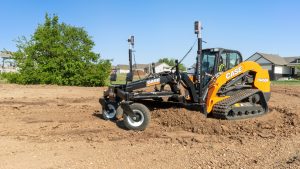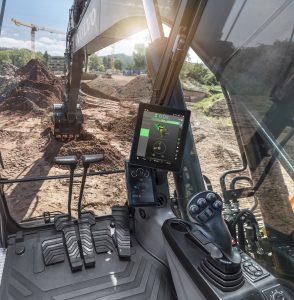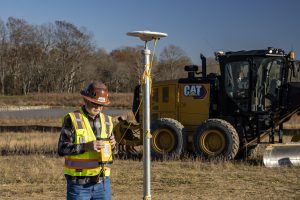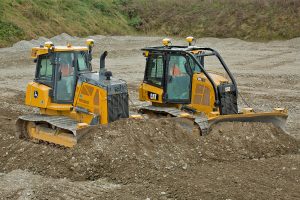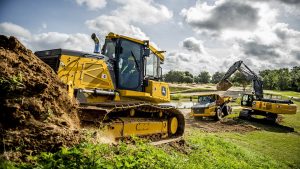
Getting good grades
By NATE HENDLEY
Equipment Equipment TechnologyWhat’s new in grade control solutions.
Remote monitoring, wireless data transfer (WDT) and automatic/semi-automatic functions are becoming increasingly common in grade control systems. Other grade control trends include a clamour for 3D solutions even when a cheaper, simpler 2D solution might suffice.
“2D works in two dimensions usually with a rotating laser as its benchmark. It’s perfect for flat pads, simple slopes, maybe a driveway or parking lot. 3D uses GPS [or GNSS] satellite technology or a total station for more complex operations with contours, such as a super elevated turn on a highway, maybe a golf course… A lot of customers think they need 3D but, in many applications, 3D may be over the contractor’s budget or overkill,” says Richie Snyder, marketing manager for precision solutions and telematics, CASE Construction Equipment.
“2D applications can have a tighter tolerance… [Also], 3D does not necessarily always work inside tunnels — you have to see the satellites. So, a 2D application would work there. Then, there’s the initial investment. [With 2D] you don’t need a base station. You might just need a laser transmitter,” adds Scott Hagermann, senior market professional in CatGrade Technologies at Caterpillar.
Wireless data transfer meanwhile, can be used to update machines and operators to changes in design or work conditions. Connectivity also enables remote support, from construction headquarters, a dealer or manufacturer.
“With these technologies, support is as important as the initial purchase,” says Sean Mairet, product marketing manager for grade control at John Deere. “If something goes wrong or the setting seems goofy [it’s beneficial if someone can] remotely get into that machine and help the operator.”
A final trend centres on user-friendliness. Simple displays, clearly identifiable screen icons and easy-to-follow instructions are now the norm. Intuitive grading controls simplify operations for older operators who didn’t grow up with technology while reducing the learning curve for younger workers with limited job experience.
“Technology is obviously something that’s helping bridge some of the gaps with workforce availability,” Mairet says.
Come what may, it seems pretty that clear grade control technology is here to stay. In addition to allowing operators to make consistently make grade, these solutions save money and resources.
“With grade control, you don’t need as many supporting people grade-checking and setting up stakes and all,” Clark says.
Here’s a look at what’s new and/or noteworthy in grade control.
CASE CE
CASE recently introduced a new flagship product called the Precision Grader Blade for large-frame compact track loaders (CTLs).
A CTL fitted with this innovative attachment can offer the same grading performance as a motor grader, in a smaller footprint. Compatible with both 2D and 3D machine control, the Precision Grade Blade system can involve laser receivers, GPS/ GNSS satellite networks, total stations, and sonic tracers. Snyder says this solution is very intuitive.
“It’s very easy to navigate the 3D and 2D panel. We also go to great lengths to certify the dealers that sell the products, so not only do they know the applications, they also know how to support [the products] and offer training,” he says.
Working with technology partner, Leica Geosystems, CASE ensured that the Precision Grader Blade was scalable. An operator can start off using 2D then upgrade to 3D with minimum hassle or expense. Remote monitoring and online file transfer functions are also available.
“On a 3D solution, someone in the office can monitor the material that’s being cut, how the operator is progressing on the jobsite, and even upload files. So, if the project design changes, they can remotely upload that [information]. They just have to be connected to the Internet and can upload virtually from anywhere in the world,” says Snyder.
Volvo CE
Active Control is a relatively new solution from Volvo Construction Equipment that automates bucket and boom movements for precision cuts along a programmed path. Productivity is greatly enhanced. Active Control is nearly 50-per-cent faster than traditional grading, according to Volvo CE.
In addition to automated grading, Active Control offers swing control, depth limits (operators can program the solution to prevent over-digging) and height limits (operators can pre-set an elevation beyond which the bucket and boom cannot exceed).
“You also have the ability to decide whether or not to do back-grading. [If yes], do you want the back-grading to be computer-controlled, or do you want to do it yourself?” says Matthew McLean, product manager for Dig Assist at Volvo CE.
Active Control, which works in tandem with the company’s Dig Assist application and Co-Pilot display unit, offers benefits for a range of operators, he says.
“For an experienced operator, if they want to hit grade all day every time, this takes some of the guess work out of it. If you have people who aren’t that familiar with it, our system is easy to set up. You’re using a touchscreen and icons that make sense. On the screen, there’s an icon shaped like a bucket with an ‘A’. That’s Active Control. Touch that and up come selections — do you want it to control the bucket? Speed? Angle? Touch what you want and set it up,” says McLean.
Caterpillar
Cat Grade from Caterpillar blends advanced guidance with automated machine control for enhanced grading accuracy, precision, and productivity.
The 3D version of Cat Grade uses GPS signals to automatically adjust movements of the blade including tilting and lifting. This factory-integrated system can be used on both flat and contoured landscapes and features an intuitive touchscreen interface. A simpler 2D version offers two-dimensional blade control with no need for base stations or input from satellite networks.
A remote monitoring feature allows support staff to assist operators in the same way a computer technician dials into your laptop and adjusts some settings, says Hagermann. The company also offers in-person training at company sites in Peoria, Ill. and Tucson, Ariz.
“We have grade control classes, where the customer comes to our facility. We have the latest and greatest machines with the latest and greatest technology on them… [clients] go out and work on tractors, excavators, scrapers, motor graders … the guys are learning, ‘Okay, this is how this thing works,’” states Hagermann.
Trimble
Trimble’s Earthworks for Dozers grade control software offers intuitive settings and a unique Horizontal Steering Control function. This function enables the machine to automatically follow a horizontal alignment from a 3D model so operators can focus on grade and productivity.
“We’re the only provider that can automatically control a dozer in a horizontal alignment,” says Cameron Clark, earthmoving industry director at Trimble Civil Construction.
A few years ago, Trimble introduced Earthworks GO!, a pioneering, easy-to-set-up grade control solution that can be run on a mobile phone.
Earthworks GO! determines blade tip position, optimizes machine performance for specific grading tasks, and controls the machine’s automatic blade settings, among other features.
Trimble’s WorksManager solution is “another thing that’s applicable to grading,” adds Clark.
WorksManager allows machines to wirelessly receive 3D designs and other information from machines, drones, and additional data sources if work plans change.
John Deere
Last fall, John Deere announced it would be offering SmartGrade Remote Support — a new addition to the company’s SmartGrade platform — on its latest motor graders, excavators, compact track loaders and dozers.
Among other features, SmartGrade Remote Support offers remote display access (RDA) and wireless data transfer.
RDA allows a customer or dealer to see the screen live, so they can help troubleshoot. While WDT entails being able to send files remotely, if you get a change order, Mairet explains.
A few months previously, John Deere launched SmartGrade for Excavators. Designed to augment grading accuracy and productivity, this factory installed 3D solution was initially introduced on the 210G LC and 350G LC Excavators.


